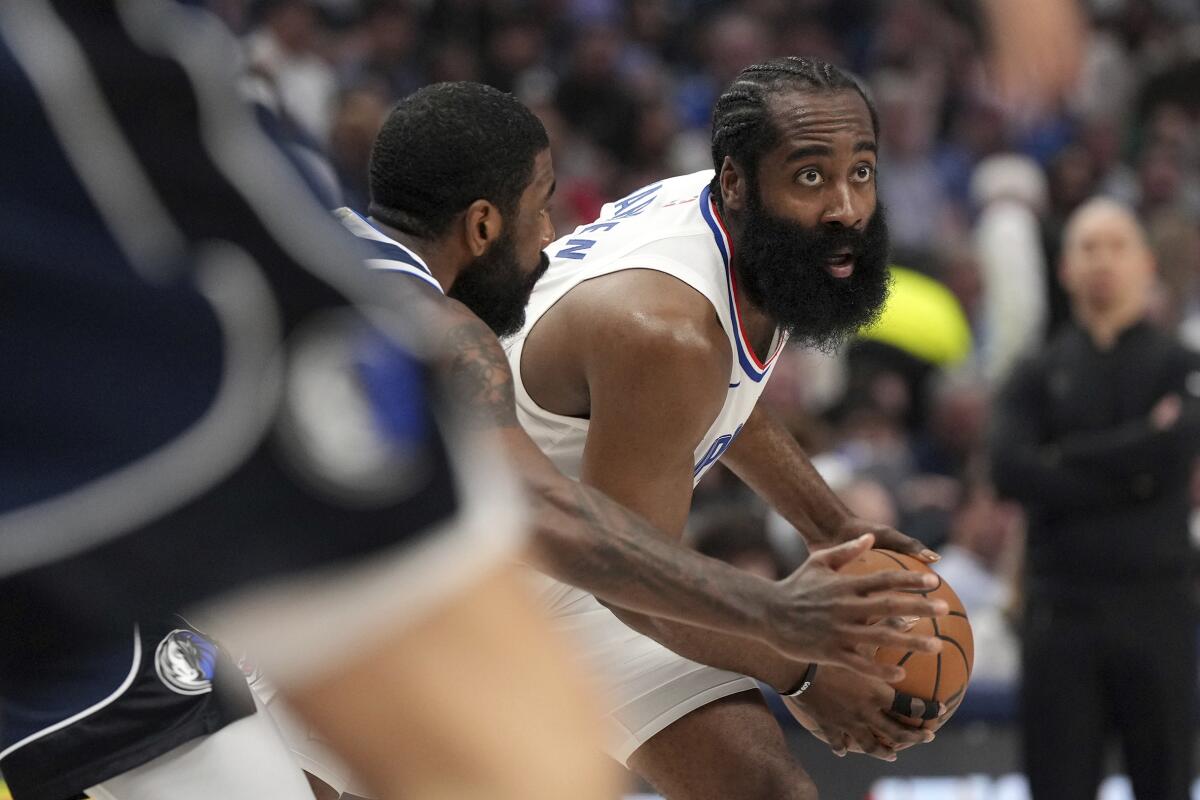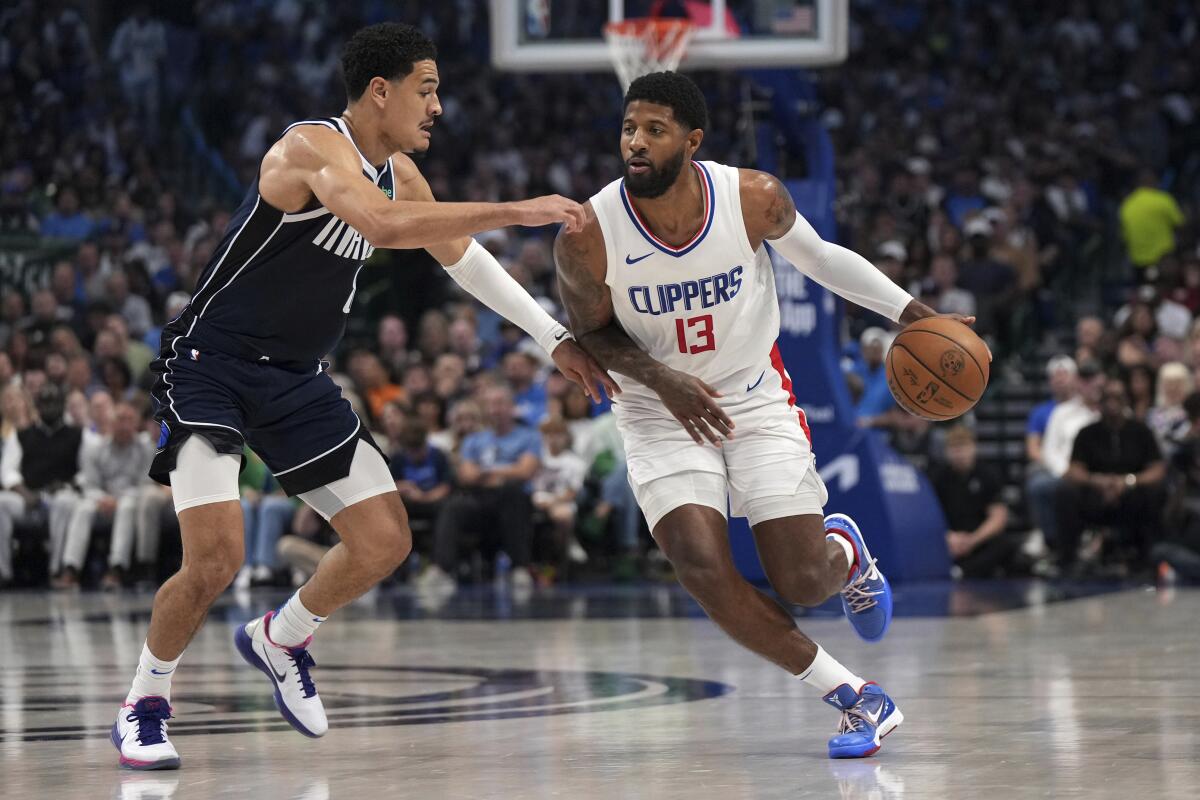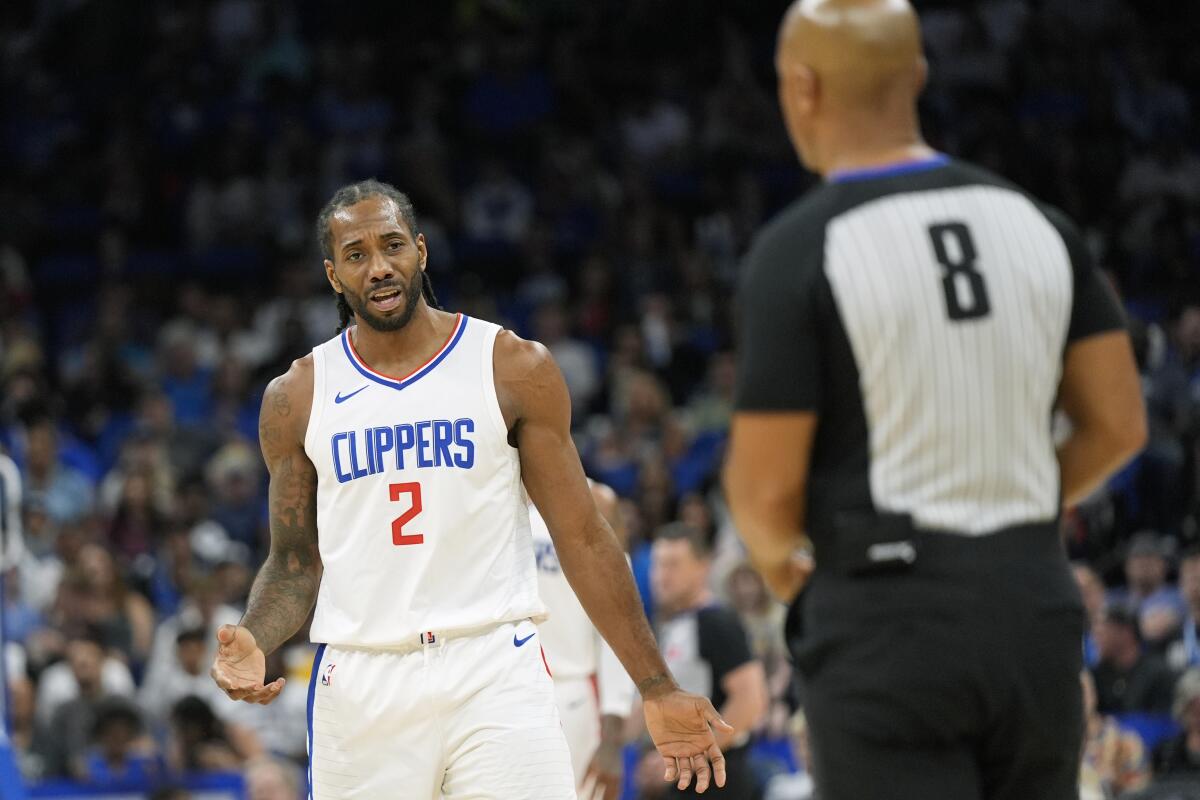James Harden closes Game 4 victory as Clippers even series with Mavericks

- Share via
DALLAS — The Clippers were missing their main cog, the absence of Kawhi Leonard because of right knee inflammation and swelling in Game 4 leaving the group short-handed in what was deemed a potential series-altering playoff encounter.
But these were the moments why the Clippers acquired James Harden, why they added another future Hall of Famer, and why they felt good about their chances even when Leonard couldn’t play.
And Harden didn’t let the Clippers down, scoring 11 of their final 16 points to help them withstand blowing a 31-point lead, finishing with 33 points in a 116-111 win over the Dallas Mavericks on Sunday afternoon at American Airlines Center.
With Harden’s seven assists and six rebounds along with Paul George’s series-high 33 points, eight assists and six rebounds, the Clippers tied the Western Conference best-of-seven series at 2-2. Game 5 is Wednesday night at Crypto.com Arena
Interestingly, the Clippers have won both games in which Leonard was sidelined.
Harden made sure of this Sunday by scoring 15 points in the fourth quarter, his five consecutive floaters down the stretch the difference.

“Game 1 we knew Kawhi was out and I had to be more aggressive,” said Harden, who made 12 of 17 shots from the field, four of five from three-point range. “Tonight we knew Kawhi was out, I had to be more aggressive. And so, it’s pretty simple for me.”
Perhaps, but the game turned tenuous when the Clippers’ big lead turned into a 105-104 deficit with 2:14 left after Kyrie Irving (40 points) scored over three Clippers’ defenders.
But the Clippers did not fold.
George hit a high-arching three-pointer for a one-point lead with 1:55 left, a lead the Clippers never relinquished despite the Mavericks charging back behind Luka Doncic’s triple-double of 29 points, 10 rebounds and 10 assists.
“I was just trying to stay in rhythm,” George said. “But I got confidence in myself. I know I can knock any shot down and get any shot off. So, I just tried to create space and find space and I was able to do so.”
Clippers coach Tyronn Lue said it was all about the team maintaining its composure.
“It was funny. I was looking at you (the media) and you were looking crazy and I said, ‘We’re OK. We’re OK.’” Lue said. “Like, they are a great team. Kyrie and Luka, they are going to make crazy shots, they are going to make some tough shots and we knew they were going to make a run. But also we didn’t think we’d come into this building and be up 31 points either. So, I told our team, ‘Just get the win, however got to get it.’”
Leonard was ruled out before the game and there was no timetable for his return, Lawrence Frank, the Clippers’ president of basketball operations, said.

Leonard sat out Game 1, returned to play 34:55 in Game 2 and then 24:32 in Game 3. But he was laboring from the start.
“He’s extremely disappointed and frustrated that he’s not playing today,” Frank said before the game. “He wants to play, but it was obviously in Game 3 that his mobility was severely restricted. So, organizationally we just made a decision that he’s out.
“The obvious question, and I know it’s coming so I’ll beat you to it, when he’s coming back? Um, can’t tell you a timeline. I wish I had a crystal ball. Basically until he can show that he can make all the movements that he needs to make, that’s when he’ll come back. That will be the time frame.”
Frank said Leonard was “obviously restricted” and that even the idea of using their best player as a shooter in the corner was not a viable option.
“Game 2, he felt fine. It was basically condition, rhythm, timing,” Frank said. “The following night some of the swelling came back. We were comfortable with what the amount of swelling was. We obviously reduced his minutes and played him in a different way. But when you watch him play, it was very obvious that that’s not Kawhi Leonard and we have to be able to get him to a point where he feels like he felt in Game 2. The expectation is that he would progress, but it didn’t work out that way so he obviously needs more time.”
Frank said the team did “another image” on Leonard’s knee and that it “structurally was intact.”
“There’s different thoughts of why there’s inflammation,” Frank said. “He’s doing around the clock every [method] you can do. The medical staff is doing everything that they can do and we knew that there was a chance that it could come back. It’s just hard to predict. ... There’s no acute injury. It’s just been really tricky.”

Leonard played in 68 regular-season games this season for the Clippers, the most since he played in 74 for the Spurs during the 2016-17 season.
He sat out the Clippers’ last eight regular-season games because of the issue, last playing March 31. He sat out the first playoff game against the Mavericks but played in the next two.
Last season, Leonard played in the first two playoff games against the Suns but sat out the rest of that series and it was revealed later he had a torn meniscus in his right knee.
So, with this injury of inflammation and swelling in Leonard’s knee, Frank was asked about the team’s confidence that it’s not more serious.
“Anytime a player swells up you are always looking for the reason why,” Frank said. “And when you do MRIs, obviously you are looking for the main structures: the ACL, the MCL, the PCL. ... All of that is intact, which is comforting. But he’s still dealing with inflammation and it doesn’t take a medical expert or someone who is a basketball person to realize that when you watch him play in Game 3, every movement was very, very restricted. It wasn’t like that in Game 2. So, we saw that. Like I said, he’s disappointed and upset that he’s not playing today. But ultimately at the end of the day, until he can do the movements that he needs to do on a basketball court, we’re going to hold him out.”
More to Read
Get our high school sports newsletter
Prep Rally is devoted to the SoCal high school sports experience, bringing you scores, stories and a behind-the-scenes look at what makes prep sports so popular.
You may occasionally receive promotional content from the Los Angeles Times.







